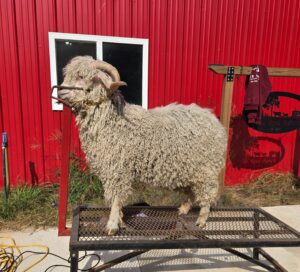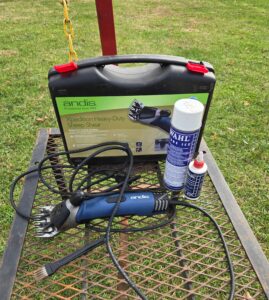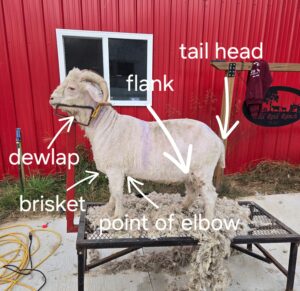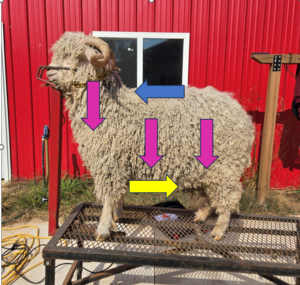To keep an Angora goat happy and healthy, they should be sheared every six months. The equipment and supplies needed for clipping mohair from an Angora goat are shown and discussed. Techniques for shearing an Angora goat on a stand are illustrated.

This post contains affiliate links. As an Amazon Associate, I earn from qualifying purchases.
People often mistake my Angora goats for sheep. It’s true that they do resemble sheep with their long, curly locks, but they are true goats with horns, upturned tails, and mohair instead of wool.
Angora goats are shorn every six months to keep them comfortable and healthy. Their mohair grows about an inch in length every month!
Reasons to Shear an Angora Goat
Even if you don’t plan on using the mohair for spinning or weaving, your Angora goat should still be shorn on a biannual basis. Keeping your goat’s mohair a manageable length makes it easier for them to stay clean and healthy.
Long mohair can become entangled with burrs and briars or matted with urine and feces. Unfortunately, contaminated fleeces are a favorite spot for flies to lay their eggs, resulting in a condition called flystrike. Flystrike is a painful and debilitating disease wherein maggots infest an animal’s coat and skin, feed on their flesh, and destroy tissue.
In addition to preventing flystrike, shearing helps keep goats (and sheep) from getting too hot in warm climates. I choose to shear my Angoras in April, before the temperatures get too high in Michigan, and in October, to facilitate breeding. Minimal fleece length on both the bucks and does can help increase the likelihood of successful mating.
Lastly, shearing is an ideal time for farmers to accurately assess their animals. A long fleece can hide signs of malnourishment, external parasites like lice and mites, or injuries. Shearing takes the guess work out of body condition scoring and allows the opportunity to give each animal a thorough once-over.
Equipment Needed for Shearing an Angora Goat

There are plenty of people in the goat world (and even more in the sheep world) that shear on the ground and lay the animal on its back in the process. That is one way to do it, but not how I choose to. I have decades of experience clipping market and breeding stock goats on a stanchion, and that is how I shear my Angoras as well.
I use a livestock trimming stand with a wire head piece to restrain my goats for the shearing process. This type of stand is nice because it is easy to clean or move and adjustable for both large and smaller animals. Plus, having the goat raised up is more ergonomic. It helps save your back because you don’t have to bend over as far during trimming.
You will want to use clippers that are made specifically for wool to shear an Angora goat. Regular clippers without wool combs and cutters are just going to get stuck and pull the mohair instead of removing it.
You will need clipper oil to keep your clippers lubricated and in good working condition. It will need to be applied periodically during shearing, so keep it close!
Blade cooling spray helps keep the clippers clean and prevents overheating. It provides some lubrication as well but does not replace the need for clipper oil. You will want to use the blade cooling spray every 2-3 minutes during shearing so that your clippers don’t get too hot and turn off.
Most clippers come with a cleaning brush for removing the hair, dirt, and oil that builds up around the combs and cutters. If you don’t have one, an old toothbrush works just as well.
A Review of Goat Anatomy
Before shearing an Angora goat, it is important to review goat anatomy really quick so that you don’t accidentally cut your animal. Goats have several areas with loose or folded skin that, on an Angora, will be hidden by their long locks of mohair.
You need to be especially careful when clipping the dewlap, brisket, point of elbow, flank, tailhead, and around the genitalia of your animal. If you aren’t sure where I’m talking about, find those body parts highlighted below!
In addition to being careful, keeping the skin taut and shearing slowly over these delicate areas can help prevent nicks.

Steps for Shearing an Angora Goat
- Get all your equipment ready. Set up in a flat, clear area with access to electricity. You may want an extension cord. In addition, you will need a stanchion, clippers, clipper oil, blade cooling spray, and a cleaning brush.
- Clean and oil your clippers before you start!
- Catch your Angora goat and restrain him on the stanchion. Adjust the wire head piece to a comfortable height and make sure his head is secure.
- Begin shearing on one side of the tip of the tail, continuing onto the goat’s body, and ending at the withers (base of the neck). I make one pass on the right side, and another on the left side of the goat’s spine. See the blue arrow in the picture below, demonstrating the direction to cut for this first section.
- Shear one side of the goat’s body in a downward direction. Keep the skin taut by leading and pulling gently with your non-dominant hand. Keep the comb in contact with the skin to prevent second cuts and be careful in those sensitive areas!
- Make sure you are stopping to oil and spray your clippers every few minutes.
- Repeat the same procedure on the other side of the animal. See the pink arrows in the picture below as a reminder of the cutting direction.
- Carefully clip the animal’s belly from front to back, see the directional arrow in yellow below for reference.
- There are wrinkles on the goat’s neck when their head is up, so I clip the neck in a downward direction on each side.
- To do the face and around the horns you will need to release the goat’s head from the wire head piece of the stanchion. Another set of hands is helpful to keep the animal from moving. Carefully clip the poll (top of the head) and mohair from around the eyes in a downward direction.
- Examine your work.
- If you are saving the mohair, collect and store it in a breathable bag. I use a clean feed sack to store my mohair until I have time to scour it. For more information on how I wash and process mohair, click here to read my other article!


Mother, farmer, author, and teacher by trade… She loves tending to things and watching them grow!

